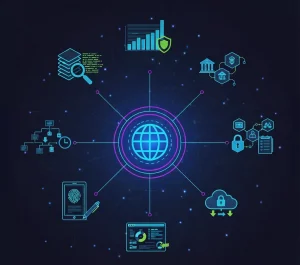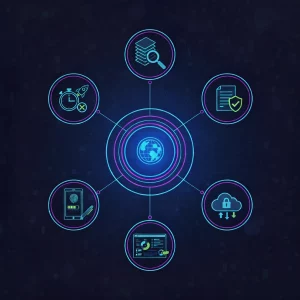Experion Technologies, a global product engineering leader, helps financial enterprises design, build, and scale next-generation digital lending platforms that merge innovation with operational precision. By reimagining the lending lifecycle through automation, analytics, and cloud-native architectures, Experion enables banks and NBFCs to accelerate approvals, improve compliance, and deliver exceptional customer experiences.
Across the financial sector, the loan origination process has historically been a manual, document-heavy sequence riddled with inefficiencies. Loan officers spend hours verifying details, underwriters navigate complex spreadsheets, and customers often endure long waiting periods for approval. The traditional approach no longer matches the agility of today’s digital-first borrowers, especially in Australia’s fast-evolving financial ecosystem, where fintechs are setting new benchmarks for speed and transparency.
That’s why institutions are turning to Loan Origination Systems (LOS), comprehensive software platforms designed to digitize and automate the lending journey from the very first application to loan disbursement.
Understanding Loan Origination

Loan origination is the foundation of any lending operation. It involves receiving applications, assessing borrower eligibility, managing risk, and ensuring compliance before disbursing funds. However, manual methods, still common across mid-tier and regional banks, often lead to delays, inconsistent decision-making, and human error.
In a digitally mature market like Australia, where regulatory scrutiny and customer expectations are both high, automation and digitization are no longer optional, they’re strategic imperatives. For enterprises striving to stay competitive, loan origination automation allows teams to reduce costs, enhance accuracy, and deliver personalized lending journeys.
Modern loan origination solutions enable banks and NBFCs to:
- Collect, process, and verify customer data in real time.
- Integrate credit scoring, identity verification, and compliance checks seamlessly.
- Enhance customer trust by offering faster decisions with complete transparency.
By transitioning from paper-based workflows to digital ones, lenders can drastically reduce operational friction while meeting the growing demand for instant credit decisions and self-service digital applications.
What is a Loan Origination System?

A Loan Origination System (LOS) is an end-to-end digital platform that automates the steps required to originate, evaluate, and approve loans. It acts as the technological backbone of lending, connecting data sources, underwriting engines, credit bureaus, and communication systems into one streamlined ecosystem.
At its core, loan origination refers to every phase that transforms a borrower’s application into a funded loan, from initial submission and documentation to verification, underwriting, and disbursement. A loan origination system workflow replaces fragmented manual steps with unified automation, enabling transparency and traceability at every level.
Advanced loan origination software incorporates decisioning algorithms, risk scoring models, and analytics dashboards, ensuring both operational speed and regulatory compliance. It empowers lenders to scale faster and respond dynamically to evolving borrower expectations.
Reimagine Lending. Reinforce Trust →
Explore how digital loan origination transforms financial ecosystems
Types of Loan Origination Systems
The loan origination ecosystem has diversified, offering purpose-built systems tailored for specific lending needs:
- Retail Loan Origination Systems
Designed for consumer loans such as auto, education, and personal loans. These systems focus on volume processing, minimal human intervention, and quick credit decisions. - Commercial Loan Origination Systems
Built for complex lending such as business credit, working capital, or project finance. They manage multifaceted approval chains, collateral evaluations, and compliance documentation. - Mortgage Origination Systems
Handle high-value housing loans and integrate with valuation platforms, title verification systems, and regulatory frameworks. - Consumer Loan Systems
Streamlined solutions for small-ticket, high-volume lending, ideal for fintechs or digital-first NBFCs that serve large customer bases. - Peer-to-Peer (P2P) Lending Platforms
Facilitate direct transactions between lenders and borrowers using AI in loan origination for risk scoring and predictive analytics to reduce default rates.
Each type of system aligns with unique business models, customer segments, and compliance obligations, allowing lenders to adopt a modular or holistic approach based on their strategy.
Core Objectives of Implementing a Loan Origination Platform
The implementation of a loan origination platform serves several strategic objectives for financial institutions:
- Process Efficiency: Automate repetitive tasks, minimize bottlenecks, and accelerate approvals without compromising due diligence.
- Data Integrity and Accuracy: Centralize customer data and reduce discrepancies caused by manual entry.
- Regulatory Compliance: Integrate compliance checks and audit trails to meet KYC, AML, and data protection requirements.
- Scalability: Support increasing loan volumes and new product lines without major infrastructure changes.
- Customer-Centricity: Deliver a seamless, transparent, and responsive experience that builds trust and loyalty.
- Innovation Enablement: Facilitate the integration of AI, analytics, and cloud for continuous improvement.
For Australian banks and NBFCs, the goal isn’t just digital transformation, it’s sustainable transformation that balances innovation with trust and governance.
Key Stages in the Loan Origination Process
Every lending journey follows a predictable pattern, application, assessment, approval, and funding. Yet, in traditional settings, each stage is weighed down by manual verification, redundant paperwork, and poor data visibility. A modern loan origination system workflow automates and connects these stages, transforming how financial institutions evaluate and serve customers.
- Application and Document Collection
Borrowers today expect digital-first experiences. Whether through a web portal or mobile app, an AI-enabled loan origination platform streamlines this entry point.
Customers can complete applications online, upload supporting documents, and electronically verify details. The system validates data instantly, reducing back-and-forth communication and minimizing human error.
- Credit Scoring and Underwriting
This is the heart of any loan origination solution. Integrated credit-scoring engines combine traditional bureau scores with alternative data, such as transaction history, utility bills, or social signals, to create a more complete borrower profile.
For Australian lenders navigating diverse SME and retail markets, AI-driven loan origination automation allows for real-time underwriting that balances agility with accuracy.
- Verification and Validation
Instead of manually chasing documentation, an automated LOS connects with APIs for eKYC, income verification, and property evaluation. Cloud-based systems ensure that these checks occur simultaneously, speeding up turnaround time while preserving auditability.
- Approval and Loan Disbursement
Once risk thresholds are met, automated decision engines trigger approval notifications and disbursement workflows. Funds are transferred directly to the borrower’s account, and compliance checks are logged for regulatory review.
The result is a faster, more transparent process that enhances customer confidence and brand credibility.
- Post-Loan Monitoring and Customer Engagement
Modern lenders go beyond disbursement. Embedded analytics in the best loan origination software enable continuous monitoring of repayment behavior, delinquency risks, and customer interactions.
This data fuels proactive engagement, offering refinancing, top-ups, or new loan products to qualified borrowers, enhancing both revenue and customer retention.
In essence, the loan origination system serves as the nerve center of the lending lifecycle, enabling lenders to deliver a seamless experience while maintaining control and compliance.
Core Features of the Best Loan Origination Software
The success of any loan origination system software lies in its ability to combine flexibility, security, and intelligence. The following features form the cornerstone of a high-performing LOS:

- Automated Data Collection and Document Management
Centralized, paperless workflows allow teams to collect, store, and retrieve customer information in seconds. Document OCR (Optical Character Recognition) tools digitize physical forms for automated processing. - Credit Scoring and Risk Assessment Integration
Real-time integration with credit bureaus, bank statement analyzers, and alternative-data APIs ensures precise, AI-driven evaluations that evolve with market trends. - Workflow and Process Automation
Rule-based engines dynamically assign tasks, generate alerts, and ensure SLA adherence. This minimizes delays and reduces dependency on manual oversight. - eKYC and Digital Signature Capabilities
Secure digital verification and signing simplify onboarding, especially for remote borrowers—a critical capability in Australia’s geographically dispersed market. - Compliance and Audit Tracking
Every decision and transaction is logged automatically, simplifying audits and ensuring adherence to APRA, ASIC, and other financial regulations. - Analytics and Reporting Tools
Dashboards provide insights into loan performance, operational efficiency, and default probabilities, enabling data-driven strategic decisions. - Integration with Core Banking and CRM Systems
APIs and middleware connect the LOS with legacy banking systems, CRMs, and payment gateways, creating a unified data environment.
Collectively, these capabilities enable financial enterprises to maintain speed without sacrificing governance, a balance crucial for growth in the digital era.
Benefits of Implementing Loan Origination Systems
Implementing loan origination systems is not merely an IT upgrade; it’s a strategic transformation. The benefits extend across operational, financial, and customer-experience dimensions.

- Reduced Turnaround Time and Faster Approvals
A digitized LOS reduces loan processing from days to minutes, driving competitiveness in a crowded market. - Enhanced Accuracy and Reduced Manual Errors
Automation ensures data consistency, eliminating duplication and subjective decision-making. - Better Compliance and Data Security
Built-in controls and audit trails provide transparency and readiness for regulatory reviews. - Improved Customer Experience and Transparency
Borrowers enjoy real-time application tracking, quick updates, and proactive communication, all of which foster trust. - Scalability and Operational Efficiency
A cloud-based loan origination system allows banks and NBFCs to handle increased volumes without additional infrastructure costs.
For lenders in Australia, these advantages align perfectly with the sector’s digital-first evolution and regulatory push toward open banking and secure data sharing.
How Do Loan Origination Solutions Empower Financial Institutions in Australia?
Australia’s financial ecosystem, shaped by progressive regulations, open-banking reforms, and growing fintech competition, is witnessing a lending revolution.
Loan origination solutions play a pivotal role by:
- Driving Digital Transformation
Modern LOS platforms help institutions transition from legacy systems to agile, cloud-based architectures, enabling omnichannel access for customers. - Enabling Personalized Lending Experiences
Through data analytics and AI-driven insights, lenders can craft tailored products and flexible repayment terms, enhancing borrower engagement. - Improving Decision Quality with AI and Analytics
AI in loan origination empowers risk teams to forecast repayment behavior and detect anomalies, ensuring sound portfolio management. - Strengthening Portfolio Performance and Risk Management
Integration of predictive analytics minimizes non-performing assets (NPAs) and supports data-driven credit policies.
Experion Technologies, leveraging its proven product-engineering expertise, collaborates with financial institutions across Australia to design scalable loan origination systems that align with their unique business and compliance needs. By combining domain depth with technological innovation, Experion enables lenders to create transparent, customer-centric, and resilient digital ecosystems.
Loan Origination System vs. Loan Management System
Although closely connected, loan origination systems (LOS) and loan management systems (LMS) address distinct phases of the lending lifecycle. Understanding this difference is essential for institutions planning full-stack modernization.
| Aspect | Loan Origination System (LOS) | Loan Management System (LMS) |
| Primary Function | Application intake, credit assessment, approval, and disbursement. | Post-disbursement servicing, repayment tracking, and collections. |
| Focus Area | Risk evaluation, onboarding, and compliance verification. | Account management, amortization, and customer relationship upkeep. |
| Users | Underwriters, credit officers, relationship managers. | Operations, finance, and customer-service teams. |
| Output | Approved loan ready for booking and funding. | Loan lifecycle management until closure or renewal. |
While LOS initiates the lending journey, LMS sustains it.
For a complete lending ecosystem, both systems must operate in tandem, sharing data, automating workflows, and ensuring a seamless borrower experience. Many forward-thinking institutions now adopt integrated loan origination and management platforms to reduce silos and maintain real-time visibility across the lending value chain.
The Role of AI in Loan Origination

Artificial Intelligence is redefining the boundaries of modern lending. By integrating AI in loan origination, financial institutions can automate complex decisions, identify risks earlier, and deliver personalized customer journeys.
In an environment where accuracy, compliance, and speed coexist as top priorities, AI brings precision and agility that traditional systems can’t match.
- AI-Powered Credit Scoring and Fraud Detection
Traditional credit scoring relies primarily on static bureau data, which may not capture the full financial behavior of a borrower. AI models, however, use dynamic datasets, including spending habits, digital footprints, and social indicators, to assess creditworthiness with greater accuracy.
This enables lenders to extend credit responsibly to underbanked populations, supporting financial inclusion. AI also detects anomalies in documentation or application behavior, helping institutions flag potential fraud before disbursement.
- Automated Decisioning Engines
A key advantage of AI-based loan origination systems is the ability to make instant, rules-based decisions. Decisioning engines analyze thousands of parameters, income stability, repayment patterns, industry benchmarks, to provide rapid yet compliant approvals.
This improves both scalability and borrower satisfaction, as customers receive near-instant responses on their loan applications.
- Predictive Analytics for Loan Performance Forecasting
AI models track repayment behavior over time and generate predictive insights about loan performance, default probability, and customer lifetime value. For financial institutions in Australia’s competitive credit landscape, such insights help refine risk strategies and optimize portfolios.
- Real-Time Customer Insights and Segmentation
AI-driven segmentation allows lenders to tailor offers, recommend refinancing options, or introduce new products based on customer behavior. As a result, loan origination solutions evolve from transaction engines into relationship-building platforms, helping banks nurture long-term engagement.
In essence, AI transforms loan origination systems from operational tools into intelligent ecosystems that learn, adapt, and evolve continuously.
Digitize. Decide. Disburse →
See how Experion is helping lenders scale with precision
Identifying the Right Loan Origination System for Your Business
Selecting the best loan origination software requires aligning business goals, compliance needs, and future-readiness. For institutions operating in complex regulatory environments like Australia, this decision impacts scalability, cost efficiency, and long-term sustainability.
Key Evaluation Factors
- Scalability and Performance
The chosen loan origination system software should handle high transaction volumes and diverse product portfolios without performance degradation. - Integration Capabilities
Seamless API integration with existing CRMs, core banking systems, and payment gateways ensures a unified ecosystem that minimizes data silos. - Compliance and Security
Built-in audit logs, access control, and encryption capabilities ensure alignment with APRA and ASIC standards while maintaining customer trust. - Customization and Flexibility
Every financial institution has unique workflows. A configurable system allows teams to adjust approval hierarchies, scoring models, and documentation requirements with ease. - User Experience and Accessibility
Both employees and customers should experience a simplified interface, intuitive dashboards for staff and mobile-friendly applications for borrowers. - Deployment Model
-
- On-Premise LOS offers data sovereignty and control, ideal for large institutions with in-house IT teams.
- Cloud-based loan origination systems, on the other hand, provide faster deployment, reduced infrastructure costs, and easy scalability, making them perfect for mid-size lenders and fintechs.
Tips for Successful LOS Implementation
- Start Small, Scale Smart: Launch with a focused product segment, evaluate KPIs, and expand progressively.
- Ensure Stakeholder Alignment: Involve credit, IT, and compliance teams early to streamline adoption.
- Prioritize Training and Change Management: Educate teams to adapt to digital workflows.
- Measure and Optimize Continuously: Track metrics like average processing time, NPA ratios, and customer satisfaction to refine performance.
When well-executed, LOS implementation becomes a catalyst for digital maturity, accelerating operational excellence while reducing total cost of ownership.
Future of Loan Origination Systems
The financial technology landscape is undergoing a radical shift, and loan origination platforms are at the forefront of this transformation. The future will be defined by smarter integrations, deeper personalization, and greater regulatory alignment.
Emerging Trends: AI, Blockchain, and Open Banking
The convergence of AI, blockchain, and open banking is transforming how lenders process, verify, and secure transactions.
Blockchain ensures tamper-proof document validation and transparent audit trails. Open banking APIs allow lenders to access real-time financial data, enhancing underwriting accuracy and speed.
Hyper-Personalization in Lending
Borrowers increasingly expect offers tailored to their lifestyles, spending behavior, and risk profiles. Through analytics and behavioral modeling, future loan origination systems will deliver hyper-personalized lending experiences at scale, making every interaction contextual and meaningful.
Role of Regulatory Technology (RegTech)
RegTech integration within loan origination solutions ensures continuous compliance monitoring. Real-time alerts, AI-driven audit reports, and automated policy updates simplify adherence to evolving financial regulations in markets like Australia.
Predicting the Next Phase of Digital Lending Evolution
The next era of lending will be driven by self-serve ecosystems, where borrowers initiate, track, and manage loans independently through digital interfaces. Financial institutions will transition from loan providers to digital experience partners, offering end-to-end engagement powered by AI, automation, and secure cloud infrastructure.
Smarter Loans Start Here →
Learn how AI and automation are redefining lending efficiency
How Experion Can Help You in Implementing Loan Origination Systems
Experion Technologies, a global product engineering leader, has been at the forefront of enabling digital transformation in financial services.
With two decades of expertise in developing intelligent financial platforms, Experion helps banks, NBFCs, and fintechs build scalable, secure, and AI-driven loan origination systems tailored to their strategic goals.
Our approach to loan origination system development focuses on:
- Platform Engineering Excellence: Leveraging modern architectures to ensure reliability, scalability, and high availability.
- Automation-Driven Efficiency: Integrating workflow automation and decisioning engines for faster credit approvals.
- AI and Analytics Integration: Enhancing credit scoring, fraud detection, and customer engagement with predictive intelligence.
- Compliance-Ready Design: Ensuring alignment with local and international regulatory standards.
- Human-Centric Experiences: Delivering intuitive user interfaces and seamless borrower journeys.
By combining deep domain understanding with engineering innovation, Experion empowers financial institutions to evolve beyond digital adoption—to digital leadership.
Conclusion
As global lending continues to evolve, the importance of a robust loan origination system cannot be overstated. From accelerating loan approvals and enhancing risk assessment to delivering exceptional borrower experiences, a well-implemented LOS lies at the heart of every successful digital lending strategy.
Institutions that embrace loan origination automation position themselves to compete effectively in a market defined by agility and trust. Whether deployed on-premise or as a cloud-based loan origination system, the goal remains the same: to unify technology and intelligence for sustainable growth.
Experion continues to enable forward-thinking financial institutions to engineer the future of lending, through secure, scalable, and intelligent platforms that deliver excellence in every step.
Key Takeaways
- A loan origination system digitizes the end-to-end lending process—from application to disbursement.
- Loan origination solutions improve efficiency, compliance, and transparency while reducing operational costs.
- AI in loan origination enables data-driven credit decisions, fraud detection, and predictive insights.
- Cloud-based loan origination systems offer flexibility, scalability, and cost efficiency.
Partnering with Experion Technologies helps financial enterprises build future-ready, compliant, and customer-centric lending ecosystems.

